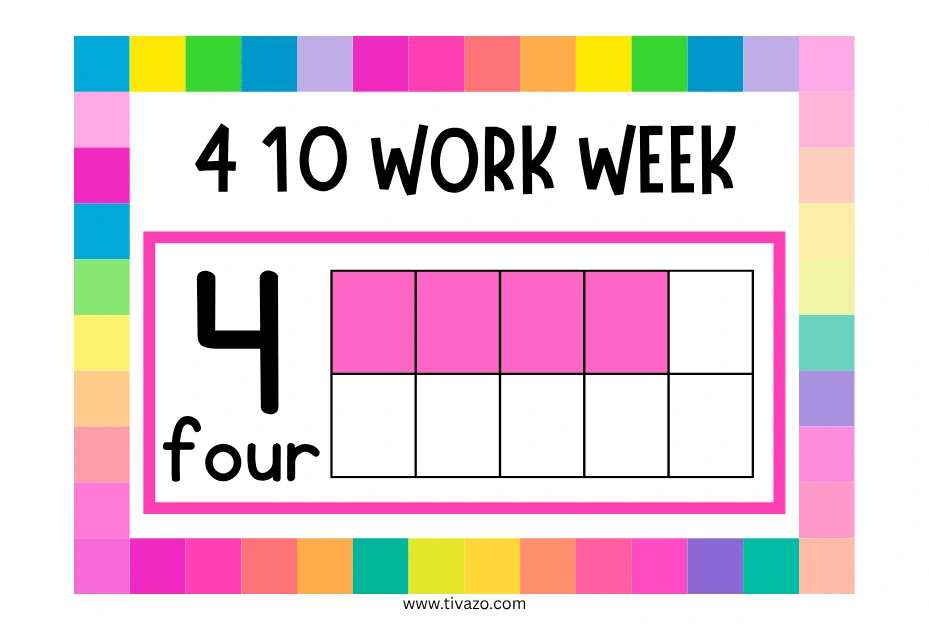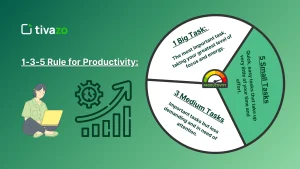What if weekly three-day weekends were possible and still wouldn’t lower your salary or cause burnout?
Here in the 4 10 work week, you forgo five normal workdays and swap them for four longer ones, so you have more balance in your life. Companies and experts who value flexibility, focus, and freedom are increasingly fond of condensed schedules.
The 4 10 work week means more than being trendy, it’s a major switch in how we approach work. Instead of the normal 9 to 5, employees on 10-hour days can get their time back, and feel less stressed, and companies enjoy better productivity and loyal staff. If your time is limited and you’re hoping to catch up, or if you own a company that wants to provide a unique advantage in hiring, this guide has everything you need to know about setting up a 4 10 work week.
Key Highlights:
- Top Benefits (Advantages) of the 4 10 Work Week
- Real-Life Success Stories Using 4 10 Work Week
- Challenges (Disadvantages) of the 4 10 Work Week
- Who Can Benefit Most from the 4 10 Work Week?
- How to Implement a 4 10 Work Week Successfully
- The Environmental Impact of a 4 10 Work Week
- Quiz
What is a 4 10 Work Week?
A 4 10 work week means employees work for 10 hours a day on four days, which equals the usual 40-hour week. This means workers get an extra day off, which results in many three-day weekends.
As a result, staffers can work more flexibly, achieve better work-life balance, and cut down travel to work meetings—all while still earning a good income and being productive. Even though the longer hours can be challenging, the shorter workweek offers many people more rest, time to focus, and flexibility.
More employers are now choosing this schedule because they care about flexibility, improved workflow, and employee wellness.
Top Benefits of the 4 10 Work Week

Besides giving us more time, the 4 10 work week leads to new ways of thinking about work and life. There’s more to the holiday than a long weekend, such as increased productivity and attracting the best workers.
1. Increased Work-Life Balance
People often point out that the 4 10 schedule improves the way work and life are combined. Working four instead of five days each week gives employees time for their loved ones, hobbies, and rest, without affecting their pay.
Having more flexibility supports your workers’ emotional well-being and helps prevent burnout. Employees who have personal time outside work usually come to the office with higher energy, a greater focus, and more satisfaction.
2. Boost in Productivity
Because time is reduced to four days, employees tend to be more focused in their work. Without distractions and with a greater desire to get things done in less time, productivity rises on its own.
A lot of businesses that follow the 4 10 work week notice major boosts in their efficiency and achievements. It makes employees better at managing their time and focus, which is good for all parties involved in the work system.
3. Reduced Commute Time
If I shave off work commuting just one day weekly, I get time back, spend less, and my stress drops significantly. Those with hard or lengthy daily commutes in cities may experience better mental and emotional health with this switch.
It is also good for the environment. A shorter 4 10 work week reduces the number of cars on the road, which leads to less carbon emissions.
4. Fewer Absences
Employees are able to go to the doctor, run personal errands, or rest—all because they have a guaranteed weekday off. As a result, there are fewer spontaneous absences, and workers follow the same routine.
Fewer unexpected sick employees help managers to schedule more accurately. The result? A team that is well-structured and usually delivers its work on time.
5. Better Employee Retention
Providing a 4 10 schedule demonstrates to employees how much their time and well-being matter to the company. Support makes workers less willing to look for a new job.
Having this benefit is very helpful now that the hiring market is so tough. Having less turnover avoids companies from spending significant amounts on recruitment and training.
6. Attracting Top Talent
It is very important to job seekers now and particularly for millennials and Gen Z, to have flexible schedules. Companies that use a 4 10 work week can distinguish themselves in a busy list of job opportunities.
It shows you appreciate new ideas, personal freedom, and caring for your employees. Because of this, you will get hardworking staff members who want to contribute to the company’s success.
7. Mental and Physical Health Improvements
Having longer weekends helps employees unwind, recover, and look after their personal needs. The added rest, as well as extra time for working out or relaxing help improve your health in a big way.
Lower stress and better mental focus mean workers are satisfied in their jobs and have fewer days off sick. People who are healthy at work tend to be more productive and positive.
Having a 4 10 work week is about choosing to work smarter and healthier, in addition to taking less days off. It is clear that when employees enjoy more autonomy, the result is good for everyone.
What are the disadvantages of a 4 10 work week?

Though working 40 hours each week is convenient, it’s necessary to know the challenges that can occur with it. Identifying these possible problems can guide both parties to handle the transition better.
1. Longer Workdays
It can be tough for a person to handle 10 hours of work each day compared to eight. People who have to work hard physically or at home might find longer shifts to be very tough.
You must be strong throughout the shift and have good time management skills. If the work pace is improper, some workers might not be able to stay focused and keep their energy up at all times.
2. Potential for Burnout
While the extra day helps, if nurses must work for longer it can result in burnout if rest periods and shifts are not organized. Employees can become tired by the end of the workday, especially if their job responsibilities are great.
Employers should watch that their employees’ duties are not too much and rest often. To make 4 10 work weeks effective, preventing burnout matters a lot.
3. Scheduling Issues
Sometimes, arranging staff for a popular day off is tough for every business. Taking care of shift coverage and running efficiently can be very difficult to organize.
Job scheduling is often handled in a rotating way, which can influence teamwork and information sharing. Arranging schedules correctly is necessary to take advantage of a shorter workweek.
The 4 10 work week is not ideal for all workers, but being aware of the problems helps companies and employees adjust to get the most benefits while lowering stress.
Real-Life Success Stories Using 4 10 Work Week
Here is a real story of a tech business that starts to work on a 4 10 work week to make their staff happier. A few months after implementing these changes, productivity went up by 20%, and there was a major reduction in employee stress. Having an extra day gave workers time for their personal life and helped them focus better during their work week. In addition to improving internal morale, the flexible workweek also helped the company get more top talent. By working just 4 days a week, their employees are healthier, and businesses have achieved better outcomes.
Who Can Benefit Most from the 4 10 Work Week?
1. Tech companies that rely on focused, individual work
2. Healthcare and emergency services, where long shifts are standard
3. Creative agencies where employees value uninterrupted creative time
4. Remote-first organizations looking to offer more flexibility
How to Implement a 4 10 Work Week Successfully

A 4 10 work week can really change things for the better, but it needs careful preparation and honest communication. A strategic plan helps prevent the new schedule from impacting regular business functions and helps increase productivity.
1. Start with a Trial Period
Test out a 4 10 work week with one department in the beginning, to see if it works well. By using a trial phase, you can improve the new schedule, understand obstacles, and address these before applying the new approach to the entire company.
2. Set Clear Expectations
Proper communication plays an important role during a switch to a compressed workweek. Staff are expected to grasp that flexibility comes with the condition of achieving their targets and work objectives, which remain top priorities.
3. Monitor Performance Metrics
Routinely observe employee work, employee happiness, and service given to customers. Keeping track of these figures shows if the 4 10 work week works as expected and points out areas that can be worked on.
4. Offer Support
Respond to employee opinions and concerns as you go through the transition. Realize that there are team members who are comfortable with regular working hours, so letting them choose can improve how happy they are at work.
Following the 4 10 work week in a planned manner reduces stress and improves the results of the business.
The Environmental Impact of a 4 10 Work Week
A shorter workweek such as 4 10, may actually help the environment since it means employees travel less to work. When people work remotely, there are fewer vehicles used for commuting, fewer polluting gases released, and less traffic. Because employees travel less, companies can cut back on their emissions, so the compressed schedule is both good for business and good for the environment.
As well as helping people get to work on time, the 4 10 schedule can reduce the amount of energy offices use. When businesses are closed one day each week, they can reduce their electric, heating, and cooling expenses. All these environmental benefits mean that the 4 10 work week is eco-friendly and benefits both workers and employers.
Comparison Table: 4 10 Work Week vs Other Alternative Schedules
| Work Schedule | Total Work Hours/Week | Workdays/Week | Hours/Day | Key Benefits | Common Challenges | Best For |
| 4 10 Work Week | 40 hours | 4 days | 10 hours | 3-day weekend, improved focus, fewer commutes | Long workdays, potential burnout | Tech, remote teams, creative industries |
| 5 8 Work Week (Traditional) | 40 hours | 5 days | 8 hours | Routine, stable hours, easy to manage | Less flexibility, more commuting days | Most businesses |
| 9/80 Work Schedule | 80 hours every 2 weeks | 9 days/2 weeks | Mix of 8–9 hours | Alternating Fridays off, work-life balance | Slightly complex tracking/logistics | Corporate teams, administrative roles |
| Flexible Hours (Flex Time) | Varies | Varies | Varies | Personalization, autonomy | Harder to manage teams & track performance | Freelancers, hybrid teams |
| 4-Day Work Week (32 hrs) | 32 hours | 4 days | 8 hours | Shorter total hours, high well-being | Potential drop in coverage/output | Progressive startups, experimental companies |
| Compressed Work Week (Custom) | Varies | 3–4 days | 10–12 hours | Maximum days off, fewer commutes | High daily fatigue, not suitable for all | Health, manufacturing, warehouse roles |
Is the 4 10 Work Week Right for You? (Take the Quiz)
Answer the following 7 questions and tally your points to find out!
1. How do you feel about working longer hours each day?
A. I don’t mind as long as I get an extra day off (3 points)
B. I prefer shorter, consistent workdays (1 point)
C. I’m open to trying it out (2 points)
2. How important is having a 3-day weekend to you?
A. Very important—I value my personal time (3 points)
B. Not a big deal—I’m okay with a 2-day weekend (1 point)
C. Somewhat important—it depends on the week (2 points)
3. Can you stay focused and productive for a 10-hour workday?
A. Yes, I already do that or can adapt easily (3 points)
B. No, I usually max out after 8 hours (1 point)
C. Maybe, with the right breaks and setup (2 points)
4. Do you have caregiving or family responsibilities after work?
A. No, I have a flexible personal schedule (3 points)
B. Yes, and I need to be available in the evenings (1 point)
C. Sometimes, but I can adjust (2 points)
5. What type of work do you do?
A. Independent or remote work (3 points)
B. Client-facing or shift-based work (1 point)
C. Team collaboration with flexible options (2 points)
6. How do you handle changes in routine?
A. I adapt quickly and enjoy trying new systems (3 points)
B. I prefer to stick to what’s familiar (1 point)
C. I’m open to change with proper planning (2 points)
7. Do you often struggle with work-life balance in a 5-day schedule?
A. Yes, I need more personal time (3 points)
B. No, my current schedule works fine (1 point)
C. Sometimes—it depends on workload (2 points)
Your Results:
👉17–21 points
Yes! The 4 10 Work Week Is Perfect for You
You’re adaptable, focused, and value your personal time. A compressed schedule with long weekends sounds like a great fit. You’ll likely thrive with this setup!
👉12–16 points
Maybe—With Some Adjustments
You might benefit from a 4 10 work week, but it depends on your workload and lifestyle. Try a trial run or hybrid model to see if it suits you long term.
👉7–11 points
Not the Best Fit
The traditional 5-day workweek may be better for your energy, responsibilities, or role. That’s okay—productivity isn’t one-size-fits-all.
Final Thoughts
Rather than just a trend, the 4 10 work week is a better way to view how we manage our jobs and our lives. When thought out properly, it leads to major advantages for employers and employees.
Both business owners hoping to adapt and job seekers with flexible goals might find the 4 10 work week make all the difference.
Try a 10-hour day today to succeed in tomorrow’s work world.
What country is doing 4 day work week?
Iceland successfully trialed the 4-day work week, and countries like the UK, Spain, and Japan are also experimenting with it to improve employee well-being and productivity.
What is the healthiest work schedule?
The healthiest work schedule is a consistent daytime shift with regular hours, allowing for adequate sleep, work-life balance, and minimal stress.
Which country has the shortest work week?
The Netherlands has the shortest average work week, with full-time employees typically working around 29 hours per week.




